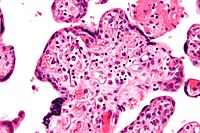
Photo from wikipedia
Introduction Small for gestational age (SGA) infants are at a higher risk of neurodevelopmental delay than infants appropriate for gestational age (AGA). Previous studies have confirmed that gut microbiota in… Click to show full abstract
Introduction Small for gestational age (SGA) infants are at a higher risk of neurodevelopmental delay than infants appropriate for gestational age (AGA). Previous studies have confirmed that gut microbiota in early life influences subsequent neurodevelopment. However, few studies have reported corresponding data in SGA populations. Objective We aimed to evaluate the characteristics of the gut microbiota of term SGA infants and the associations between the gut microbiota in SGA infants and neurodevelopmental outcomes at 6 months of age. Methods Fecal samples were collected on days 1, 3, 5, and 7 from term SGA and AGA infants born between June 2020 and June 2021 at the Peking University First Hospital. 16S ribosomal deoxyribonucleic acid amplicon sequencing was used to analyze the fecal microbiota. We followed up for 6 months and used the Ages and Stages Questionnaires-3 (ASQ-3) to evaluate the neurodevelopmental outcomes among SGA infants. Results A total of 162 neonates were enrolled, with 41 SGA infants (25.3%) in the study group and 121 AGA infants (74.7%) in the control group. The gut microbial diversity in the SGA group was lower than that in the AGA group on days 1, 3, 5, and 7. Non-metric multidimensional scaling and analysis of similarities showed significant differences between the two groups. The SGA group had increased relative abundances of Ralstonia (3, 5, and 7 days) and Clostridium (3 and 7 days). The dominant microorganisms of the SGA group were Ralstonia on day 1, Escherichia_Shigella on days 3 and 7, and Clostridia on day 5. We found that the gut microbial diversity of SGA infants with poor communication scores was higher than that of SGA infants with good communication scores on day 3. Fine motor scores were negatively correlated with the relative abundance of Bacteroides_fragilis on day 1. A negative correlation was observed between gross motor scores and relative abundance of Clostridium_saccharobutylicum on day 7. Bacteroidota, Bacteroidia, Bacteroides, and Bacteroides_fragilis were the dominant microorganisms in the good communication score group on day 7. Communication scores were positively correlated with the relative abundance of Bacteroidota, Bacteroides, and Bacteroides_fragilis on day 7. Conclusion The gut microbial diversity of term SGA infants was significantly lower in the first week of life than that of term AGA infants. Certain pathogenic and conditional pathogenic bacteria, such as Escherichia_Shigella, Ralstonia and Clostridium increased or formed the dominant microbiota in SGA infants. Alpha diversity, Bacteroidota, Bacteroides, Bacteroides_fragilis, and Clostridium_saccharobutylicum found in SGA infants may be associated with neurodevelopmental outcomes at 6 months of age, indicating possible therapeutic targets for clinical intervention.
Journal Title: Frontiers in Microbiology
Year Published: 2022
Link to full text (if available)
Share on Social Media: Sign Up to like & get
recommendations!